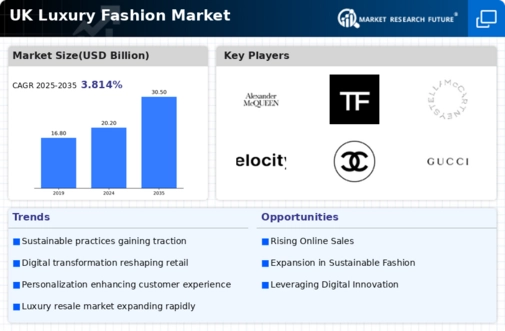The UK Luxury Fashion Market is characterized by a dynamic and competitive landscape where brands strive to distinguish themselves through innovation, quality, and brand loyalty. With a consumer base that increasingly values exclusivity and sustainable practices, companies within this sector are continuously evolving to meet changing preferences and shopping behaviors. As the market encompasses a mix of established luxury houses and emerging designers, understanding the competitive insights requires a deep dive into the strategies that define brand positioning, customer engagement, and market share.
Recent years have shown that the market's resilience against economic fluctuations and the ongoing digital transformation are key factors influencing its trajectory, shaping how luxury is marketed and consumed across the UK.Alexander McQueen has established itself as a formidable player within the UK Luxury Fashion Market, renowned for its avant-garde designs and theatrical runway presentations that drive significant interest and admiration. The brand’s strength lies in its unique ability to blend traditional craftsmanship with modern artistry, creating pieces that resonate deeply with consumers seeking both sophistication and innovation.
Beyond its striking collections, Alexander McQueen has effectively harnessed digital platforms to enhance its market presence, engaging a broader audience and cultivating a loyal customer base. The brand's commitment to sustainability, alongside its rich heritage rooted in British fashion, further solidifies its appeal, allowing it to maintain a competitive edge in the luxury segment.Tom Ford, known for its high-end fashion and accessories, has made a notable impact in the UK Luxury Fashion Market through its emphasis on luxury lifestyle branding.
The company offers a wide range of products, including clothing, eyewear, fragrances, and cosmetics, which are characterized by a sophisticated and modern aesthetic that appeals to affluent consumers. Tom Ford’s presence in the UK is reinforced through flagship stores in prestigious locations, along with a robust online presence that caters to a growing demand for e-commerce in luxury shopping. Additionally, the brand has strategically engaged in partnerships and collaborations that enhance its market position while expanding its reach. Its strong focus on quality craftsmanship combined with a distinctive, glamorous identity allows Tom Ford to maintain a competitive advantage.
The brand has also shown agility in navigating the market through effective marketing campaigns and expansion efforts, ensuring its relevance and desirability in the evolving landscape of British luxury fashion.















